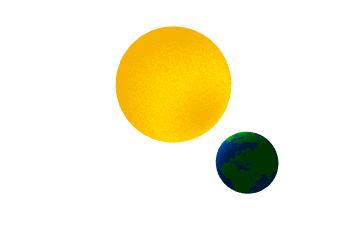How Long To Travel A Light Year
I am such a nerd...while waiting for something to happen with my computer, partly inspired by a picture of Jupiter, I queried to myself "I wonder how long it would take the Earth to orbit one light-year."
 A light-year, despite the "year" in it's name, is a measure of distance. For most of us, it's the rather large distance it takes light to travel in one Earth year. It's a vast distance, more than roughly nine trillion miles, conversationally, anyway.
A light-year, despite the "year" in it's name, is a measure of distance. For most of us, it's the rather large distance it takes light to travel in one Earth year. It's a vast distance, more than roughly nine trillion miles, conversationally, anyway.
It's a hard distance to grasp. We can all more or less figure out a year; that's birthday-to-birthday or happens every New Year or whatever. Basically one orbit of Earth around our sun. (Yes, I know, for those that can see the animation, the Earth is not rotating correctly and everything would be scorched...)
To try to put it in perspective, I was curious how many orbits Earth has to complete to travel one light-year. I was a little surprised to see that the answer was actually kind of hard to find. There's all kinds of science trickery that gets in the way of a truly precise answer, like exactly how long is a year, the fact that the Earth orbit is not quite circular, and that the Earth is orbiting a star that is actually moving on its own...these I am willing to lose in the rounding errors of tremendously large numbers.
A little quick searching brought me to the Wikipedia light-year and Earth pages. On their light-year we get the distance of light-year as "exactly 9,460,730,472,580.8 km" which seems rather precise. The Earth page lists all kinds of orbital characteristics, but not the distance traveled in one orbit. It does list the average orbital speed (29.783 km/s), from which we could estimate the fraction of the speed of light (exactly 299,792,458 m/s) and so on, but that seemed to math-intensive for my simple quandry.
A search of NASA gives us a few other points of information. From the NASA Earth page we get these rough numbers:
The distance around Earth's orbit is 584 million miles (940 million kilometers). Earth travels in its orbit at 66,700 miles (107,000 kilometers) an hour, or 18.5 miles (30 kilometers) a second. Earth's orbit lies on an imaginary flat surface around the sun called the orbital plane.
Since their approximation of speed is roughly the same as the other article, I consider it enough of an estimated confirmation to guess the rest is accurate. I'm assuming that someone at NASA has done the elliptical math to come up with the correct circumference, and then rounded for the conversation-level accuracy of the article. Surely additional digging could come up with an exact number, but I don't have time for that.
I thought also since I'm using a NASA approximation for one part of my equation, I should try to find the other part. A short hop from planet to galaxy reveals:
A light-year is the distance that light travels in a vacuum in a year -- about 5.88 trillion miles (9.46 trillion kilometers).
So given 9.46x1012km in a light-year, and 9.4x108km traveled by the Earth in one year, it seems that there's roughly 1x104 or 10,000 years needed for the Earth travel one light-year as it orbits the sun.
Since China claims 5,000 years of recorded history, the Earth has only traveled 1/2 of a light-year since ink was first put to papyrus (or whatever they used). For those with a more Western calendar, the 2000 years since the time epoch (BC to AD) have only allowed the Earth to travel 1/5 of a light-year. In my roughly 40 years on Earth, that's only about 1-1/2 light-days...
While browsing, I did run into plenty of other examples of other bits of information than for how long it would take the Earth to travel as far.
This site has worked out that at 60mph (roughly highway speed in the US...or normal house-to-store speed for an average teenager), it would take more than nine trillion years to reach one light-year.
Thankfully space craft travel much faster than highway speeds. The US Space Shuttle travels at about 17000-18000km/h so this site tells us it will travel one light-year in 37,200 Earth orbits. I think this might be a little off, but perhaps it's due to different considerations of "how far did I travel..." The shuttle orbits the Earth, so in addition to the travel it's doing around the Earth, it's also traveling around the sun, so arguably it's going faster than the Earth. I don't have numbers and don't want to do the math, so we'll take this website at its calculation.
The fastest man-made object is a space craft sent to study the sun, Helios. It reached speeds of 252,792km/h or about 70km/s, which is a little more than twice as fast as the Earth is moving, so it would take Helios about 5,000 Earth orbits to reach one light-year.